Widerøes Flyveselskap AS, trading as Widerøe, is a Norwegian airline, and is the largest regional airline operating in the Nordic countries. The airline's fleet of 40 Bombardier Dash 8 aircraft, and 3 Embraer E190-E2 aircraft, serves over 40 domestic and international destinations. Widerøe has a turnover of 3.5 billion kr; carries 2.8 million annual passengers; has 2,500 employees and performs 450 take-offs and landings each day. Public service obligation services to regional airports make up slightly less than half of Widerøe's operations. The remaining services are to primary airports in Northern Norway, and services from Sandefjord Airport, Torp and Bergen Airport, Flesland to other primary airports, and some international services from Oslo/Gardermoen, Sandefjord/Torp, Kristiansand/Kjevik, Stavanger/Sola, Bergen/Flesland and Trondheim/Værnes.
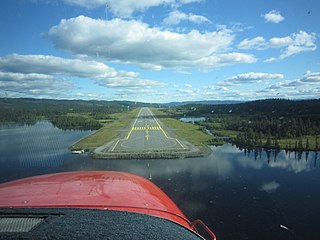
Fagernes Airport, Leirin is a general aviation airport in Fagernes, in the municipality of Nord-Aurdal, Innlandet county, Norway. It has been a airport for passenger flights, serving Fagernes and the surrounding valleys of Valdres, Hallingdal and Gudbrandsdal in Southern Norway, 190 kilometres (120 mi) from Oslo. Opened in 1987, it was owned and operated by state-owned Avinor. The airport is located 822 metres (2,697 ft) above sea level, and has a 2,049-metre (6,722 ft) runway. It did provide a regional service for the local population to Oslo, subsidized by the Ministry of Transport, as well as charter services during winter serving the nearby ski resorts. In 2014, the airport had 6,393 passengers.

Coast Air AS was a regional airline based at Haugesund Airport, Karmøy in Norway. It was Norway's fourth largest airline and operated domestic services within Norway, in addition to international services. Routes were concentrated along the West Coast, as well as some public service obligation contracts in Southern Norway. The company had a fleet of de Havilland Canada Twin Otter aircraft, later replaced with Jetstream 31s and ATR 42s.

Værøy Heliport is a heliport located at Tobbisodden on the island of Værøya in Værøy Municipality in Nordland county, Norway. The heliport lies close to the village of Sørland, the municipal centre of the municipality. The airport, operated by the state-owned Avinor, consists of a single helipad and handled 9,420 passengers in 2014. Services are provided by Lufttransport using the AgustaWestland AW139 to the nearby mainland town of Bodø, based on a public service obligation contract.
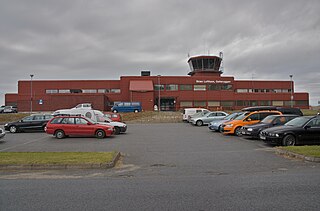
Skien Airport, Geiteryggen is a regional airport located at Geiteryggen, 5.5 kilometers (3.4 mi) southwest of the city center of Skien, Norway. Owned by Skien Municipality, it was last served by Widerøe with daily flights to Bergen. The runway is 1,416-by-30-meter and numbered 01–19. The airport had 33,080 passengers in 2014 and has Grenland and the southern part of Telemark as its catchment area.

Narvik Airport, Framnes is a former public regional airport closed down in 2017 in Narvik Municipality in Nordland county, Norway. It was located at Framnes in the town of Narvik, along the Ofotfjorden. It was operated by the state-owned Avinor and consisted of a 965-meter (3,166 ft) runway aligned 01–19.

SAS Commuter, also branded as Scandinavian Commuter, was a regional airline which operated in Denmark, Norway and Sweden. A sister company of Scandinavian Airlines (SAS), it operated various regional services on behalf of the Scandinavian flag carrier. The airline was headquartered at Copenhagen Airport, which also served as its main base. It later also operated bases at Tromsø Airport; Stockholm Arlanda Airport; Trondheim Airport, Værnes and Bergen Airport, Flesland.
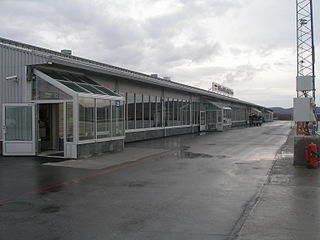
Kirkenes Airport, Høybuktmoen is an international airport located at Høybuktmoen, 15 kilometers (9 mi) west of the town of Kirkenes, in the municipality of Sør-Varanger, Troms og Finnmark county, Norway. Operated by the state-owned Avinor, the airport has a single 2,115-by-45-meter asphalt runway numbered 05-23. Scandinavian Airlines and Norwegian Air Shuttle operate Boeing 737-services to Oslo Airport, Gardermoen, in part generated by Høybuktmoen's function as a hub for Widerøe's regional services to other airports in eastern Finnmark. There are also summer charter flights to Central Europe to bring tourists to the Hurtigruten cruises. The airport had 297,149 passengers in 2013.

Lufttransport is a Norwegian helicopter and fixed-wing airline that operates primarily air ambulance helicopters and planes for the Norwegian and Swedish governments. In addition the airline offers services including surveillance for the Norwegian Coast Guard, transport of ship pilots and scheduled air transport in the Norwegian territory of Svalbard.
Norsk Air was a Norwegian airline based at Sandefjord Airport, Torp. At its height from the mid-1980s and onwards it operated scheduled flights to Stavanger, Bergen, Trondheim and Copenhagen, and for shorter periods also other Norwegian and international destinations. The airline had 156 employees and 150,000 annual passengers in 1989. The company was established as a sole proprietorship by Øyvind Skaunfelt as Vestfoldfly in 1961, after purchasing Thor Solberg's aviation school at Tønsberg Airport, Jarlsberg. In addition to an aviation college, the company operated various charter services using mostly Cessna aircraft. The company split into a flying school and an airline in 1972, with the latter taking the name Norsk Flytjeneste. Three 50-passenger Douglas DC-6 were subsequently bought and were among other places flown with aid charters to Bangladesh. Both the DC-6 and later charter flights with business jets proved unprofitable and were quickly terminated.
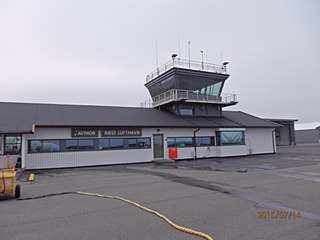
Røst Airport is a regional airport serving Røst Municipality in Nordland county, Norway. The airport is located on the northern edge of the main island of Røstlandet, just north of the main village of Røstlandet. It is owned and operated by the state-owned Avinor and handled 9,889 passengers in 2014. Services are provided by Widerøe, operating Dash 8-100 aircraft on contract with the Ministry of Transport and Communications to Bodø Airport and Leknes Airport.

Brønnøysund Airport, Brønnøy is a regional airport located at the town of Brønnøysund, in the municipality of Brønnøy, Nordland county, Norway. The airport is owned and operated by the state-owned Avinor and serves the southern part of Helgeland. It has a 1,200-by-30-meter runway numbered 03–21 and is served by Widerøe, which operates their Bombardier Dash 8 aircraft to Oslo, Trondheim, Bodø, Bergen and other airports in Helgeland. The airport also serves offshore helicopter flights by CHC Helikopter Service to Norne and temporary oil rigs in the Norwegian Sea. In 2014, the airport served 117,471 passengers, making it the second-busiest regional airport in Norway, after Florø Airport.

Hamar Airport, Stafsberg is a general aviation airport located at Stafsberg in Hamar, Norway. It features a 944-by-23-meter runway aligned 15–33 and is owned by Hamar Municipality. The airport is located in an area with very stable climate and good flying conditions.

Værøy Airport was a regional airport located just southwest of the village of Nordland on the island of Værøya in Værøy Municipality in Nordland county, Norway. Operated between 1986 and 1990, it had an 800-by-30-meter asphalt runway aligned 07–25. The airport was owned and operated by the Værøy Municipality. It was served by Widerøe, who operated de Havilland Canada DHC-6 Twin Otter aircraft to the town of Bodø and the nearby island of Røstlandet. After a fatal accident in 1990, the airport was shut down.
Coast Aero Center A/S was a regional airline based Haugesund Airport, Karmøy in Karmøy, Norway. It had only small-plane operations and mechanical services until 1984, when it acquired concessions to operate at the new Stord Airport, Sørstokken, Geilo Airport, Dagali, and eventually from Haugesund to Aberdeen. It soon turned out that the company was not profitable and it filed for bankruptcy in 1988. The estate continued on as Coast Air.

Widerøe Flight 839, also known as the Værøy Accident, was a de Havilland Canada DHC-6-300 Twin Otter that crashed shortly after take-off from Værøy Airport in Norway. The incident occurred on 12 April 1990 at 14:44, killing all five people on board. The cause of the accident were strong winds that exceeded the structure's tolerance, causing the tail rudder and tailplane to crack so the plane became uncontrollable. Impact occurred 63 seconds after take-off and 8 seconds after the crack. The aircraft crashed into the water, and a search was conducted for several days to find the wreck.

Braathens South American & Far East Airtransport A/S or Braathens SAFE was founded by ship-owner Ludvig G. Braathen in 1946. It started as a charter airline based at Oslo Airport, Gardermoen in Norway, flying to destinations in the Far East and in South America. At first the airline used Douglas DC-4s, and later also Douglas DC-3s. In 1948, the airline moved to Oslo Airport, Fornebu and started regular scheduled flights to the Far East. In 1952, the airline started cooperation with the Icelandic airline Loftleidir, where until 1960 the two airlines in cooperation flew flights to Reykjavík. Domestic services started in 1951, using de Havilland Herons on a route from Oslo to Stavanger via Tønsberg. Braathens SAFE also established at Stavanger Airport, Sola. A second route was started two years later to Trondheim. The Heron routes also stopped in Farsund, Kristiansand, Notodden to Stavanger and Hamar, Røros to Trondheim.

Widerøe Flight 744, also known as the Namsos Accident, was a controlled flight into terrain of a de Havilland Canada DHC-6-300 Twin Otter during approach to Namsos Airport, Høknesøra in Norway. The incident occurred on 27 October 1993 at 19:16:48 and killed six of the nineteen people on board, including the crew of two. The scheduled flight was en route between Trondheim Airport, Værnes via Namsos to Rørvik Airport, Ryum and the aircraft crashed at Berg in Overhalla because it held too low an altitude.
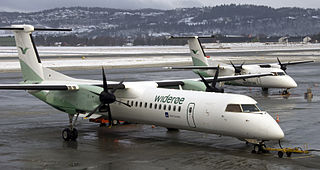
Widerøe, a regional airline based in Norway, was established by Viggo Widerøe, Einar Isdahl and Arild Widerøe on 19 February 1934. The airline started off with a combination of scheduled, aerial photography and general aviation services using seaplanes. It lost its route concessions to Norwegian Air Lines in 1935 and was subsequently bought by that company, for whom it operated several minor routes. World War II hindered Widerøe from operating any flights between 1939 and 1945. After the war Widerøe started flying various seaplane routes that were too small for DNL and its successor, Scandinavian Airlines System (SAS). These routes were commonly flown using Noorduyn Norseman and de Havilland Canada Otter aircraft. During the 1960s Widerøe attempted operating Douglas DC-3s for charter flights, but soon closed those operations.















